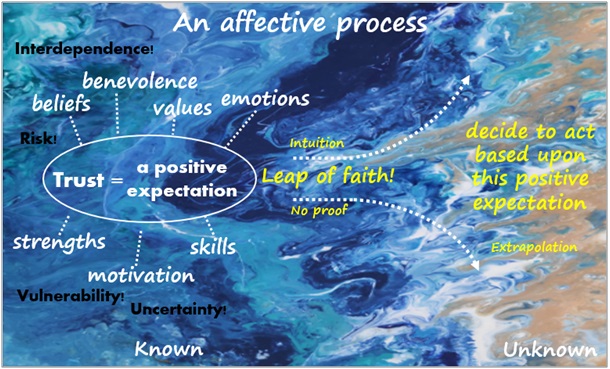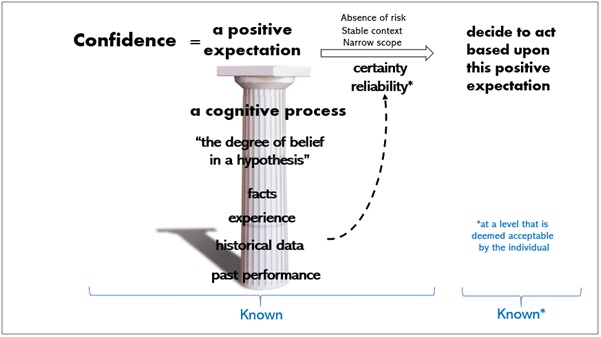
Research Paper By Paraskevi Theodoropoulou
(No Limits Coach, FRANCE)
My motivation, scope and objectives
My motivation
There is, of course, a requirement to produce a research paper to graduate from ICA. However, my motivation for the choice of this research topic was primarily intrinsic. I wanted to use the term trust or confidence in my coaching model, but I wasn’t sure which one was appropriate for my purpose. I realised that I was using the terms trust and confidence almost interchangeably, even though intuitively I knew that they had different meanings. I could not articulate the specific meaning behind each term and that started feeling like a handicap in my development. Therefore, I decided to free myself from this handicap by undertaking this research.
The scope of this paper
This research paper looks at the concepts of trust and confidence within the boundaries of a coaching conversation; the use of the two concepts in different contexts is not covered. Secondly, this paper focuses on delivering an understanding of the similarities and differences between the two concepts; hence, the portion of the academic literature that considers trust and confidence as identical terms is not included in the scope of this paper.
The objectives of this paper
The objectives of this paper are four:
Academic literature findings
This section presents the most relevant points from the academic literature review.
Trust and confidence are decisions that we make about a person, a situation or a thing/process. Deciding to trust or to have confidence is the result of some decision-making process (Adams and Webb, 2003).
Mayer (Mayer et al., 1995) suggests that confidence judgments can occur in many situations, but trust is only an issue in the presence of risk, uncertainty, vulnerability and the need for interdependency with another person. Without these situational antecedents, trust is not likely to come into play. Luhmann (1988) argues that confidence and trust are similar in that they both involve positive expectations that may or may not lead to disappointment. Trust differs from confidence, however, in that it involves a prior engagement on the part of a person to both recognise and accept that risk exists.
Madsen and Gregor (2000) describe trust being depicted as effective and confidence as being cognitive. Shaw (1997) argues that trust and confidence are different because of the knowledge underlying them, as shown in his assertion below:
confidence arises because of specific knowledge; it is built on reason and fact. In contrast, trust is based, in part, on faith.
Confidence has been described as “the degree of belief in a given hypothesis” (Griffin and Tversky, 2002).
Adams and Webb (Adams and Webb, 2003) define trust as follows:
trust is a psychological state involving positive confident expectations about the competence, benevolence, integrity and predictability of another person and willingness to act based on these expectations. Issues of trust arise in contexts that involve risk, vulnerability, uncertainty and interdependence. Trust expectations are created primarily by the interaction of the perceived qualities of the trustee and contextual factors in play when trust decisions are made.
According to Adams and Webb (Adams and Webb, 2003), a confidence judgment typically has a very specific referent and is influenced by base rates and prior probabilities. According to Adams a trust judgment typically has a broader scope and referent and is characterised by a specific lack of information, and by the need to take a “leap of faith” from what is known to what is unknown.
Discussion of the findings
The first point to note is that both trust and confidence are judgment decisions about a positive expectation; what is different is how that decision is made. This distinction is about the context and about the criteria used. After analysing the findings from the literature review, I synthesised the mechanisms of trust and of confidence in Figures 1 and 2. These visuals are the backdrop for the discussion of the findings.
 Figure 1 Synthesis of trust mechanism
Figure 1 Synthesis of trust mechanism
 Figure 2 Synthesis of confidence mechanism
Figure 2 Synthesis of confidence mechanism
Confidence refers to the concept of reliability and is based on what has been observed in the past, whereas trust refers to a belief around the character, ability or truth of somebody.
Reliability (as is defined in statistics)means the ability of a process or a person to deliver the same results under the same conditions; it is “the degree of confidence in a hypothesis”. High reliability means high predictability of the outcome, and this means high confidence. Having confidence in a person or a process means that you believe it will work as you expect it to work, under the given conditions.
Confidence is based on past performance, on historical data and there is no extrapolation from this past behaviour (no inferences are made beyond the area covered by the existing data). This gives a strict scope within which confidence is expressed. It follows that, to increase confidence levels (or self-confidence) one must generate data (i.e. have many new experiences) that will increase the reliability (the degree of belief) of the hypothesis about their behaviour and the anticipated outcomes (the hypothesis can be expressed as: “if I do X, in the given conditions, I expect to get Y as an outcome”). Based on this, from a coaching point of view a person can develop their self-confidence by focusing on two aspects:
On the other hand, trust is a belief which considers why somebody behaved the way they did, what kind of person they are, what their values are, what their motivation is, etc. The knowledge that is considered when making a trust judgment is not just cognitive, but also emotional and motivational.
Because trust decisions consider the whole person, a coaching discussion could build self-trust by supporting the client to increase their self-awareness. For example, understanding core values, motivation, strengths & talents, one’s essence energy, emotions, etc., are all part of supporting the client ‘to know thyself’.In the spirit of ‘knowing thyself,’ a coaching conversation could further support the client to find alignment between their thoughts, feelings & behaviours and their true self. Through this alignment some ‘burden’ will eventually be removed from the client (because it will not be aligned with the true self); on the other hand, new content (thoughts, feelings & actions) will be added because they are aligned to the client’s true self. It is this alignment that creates the feeling of self-trust and reduces self-doubt.
The literature makes a strong point about risk, vulnerability, uncertainty or interdependence being necessary components for questions of trust to arise. Presence of risk, vulnerability, uncertainty or interdependence dramatically reduces our degree of certainty that we have available to hold onto. Trusting is described as “taking a leap of faith, from the known to the unknown”. In the presence of risk and in the absence of data (trust is associated with the absence of tangible proof), we find the courage and we dare to listen to our intuition and act upon it. It is under these conditions that we find the courage and take a leap of faith, we transcend our current boundaries and imagine a higher self and transform our way of being.
Following on from this, learning to listen to one’s intuition is another means of increasing self-trust. This is still in the broad title of ‘to know thyself’ and coaching could support a person in removing self-inflicted pressure, silencing their ego and therefore being able to be their true self. It is in the absence of this ‘noise’ that it is possible to listen and act upon one’s intuition.
Another component of trust, presented in the academic literature, is the transition from the known to the unknown. This recalls one of the definitions of leadership, which is “being comfortable with uncertainty”. From this lens, increasing self-trust means taking more ownership and accountability of one’s own life; broadening the scope of one’s options of how to respond (responsibility) and ultimately increasing one’s personal leadership.
Both confidence and trust result in personal growth, but they do so from different angles. Confidence increases the perimeter of the comfort zone by generating tangible proof (data), therefore stretching the existing comfort zone and ultimately creating a new comfort zone which is bigger. Trust, on the other hand, throws a person from the comfort zone to the other end of the stretch zone (even sometimes crossing over into the panic zone). After some time, when this transition has happened, the new way of being is represented with a new comfort zone which, again, has a much bigger surface than before. Hence, developing both self-confidence and self-trust involve learning and personal growth.
The academic literature suggests that both trust and confidence are the results of some sort of decision-making process. The question that presents itself here is whether this decision-making process is conscious and understood by the individual. Coaching could deliver value in increasing levels of self-trust or self-confidence by supporting the client to observe their own way of thinking, their feelings and their actions, and to bring to the forefront the steps of this decision-making process. Once this process becomes conscious, it is new knowledge available to the individual to use in any way they see fit to drive themselves forward.
Conclusions& key learnings
Both trust and confidence are about having and acting upon positive expectations. Confidence is based on historical data; therefore, a person can improve their self-confidence through practice; through repetition. Trust does not require proof and comes into play only if risk, vulnerability, uncertainty or interdependence are present. Self-trust can be improved by increasing self-awareness (to know thyself) and aligning one’s thoughts, feelings and actions to their true self.
Reflecting on the notions and characteristics of trust and confidence, I realised that developing self-trust is a key input to allow developing self-confidence. The components that we find in the trust are part of the context that influences self-confidence. Since confidence is about a hypothesis in a given context, it follows that building self-trust would be a necessary initial step to lead to developing self-confidence (which would be manifested as consistency in the output).
Another key learning for me from this research is that the various ways of increasing self-trust and self-confidence presented in this document, are valid not just for the client in a coaching conversation, but also for the development of the coach. Through this work, I have discovered the components that allow me to develop my own self-confidence as a coach and the right content to use in my coaching model, regarding how to work on improving the client’s self-trust.
Bibliography
ADAMS, B.D., WEBB, R.D.G., 2003. Model of Trust Development in Small Teams. Report to the Department of National Defence. DRDC No. CR-2003-016
GRIFFIN, D., TVERSKY, A. (2002). The weighing of evidence and the determinants of confidence. In Gilovich, Griffin, D. (2002). Heuristics and biases: The psychology of intuitive judgment. (pp. 230-249). New York, NY, US: Cambridge University Press.
LUHMANN, N. (1988). Familiarity, confidence, trust: Problems and alternatives. In D. Gambetta (Ed.). Trust: Making and breaking cooperative relations. (pp. 94-108). New York: Basil Blackwell.
MADSEN, M. and GREGOR, S. (2000). Measuring Human-Computer Trust. Gladstone, Australia, Central Queensland University: 12pp.
SHAW, R. (1997). Trust in the balance. John Wiley: NY.
Mayer et al. (Academy of Management Review, July 1995) An Integrative Model of Organizational Trust. The Academy of Management Review Vol. 20, No. 3 (Jul. 1995)